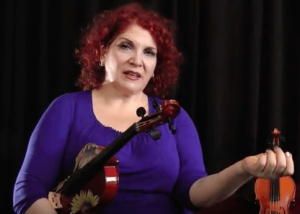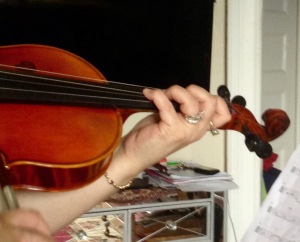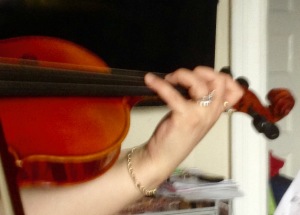Common Misconceptions About Shifting and Holding the Viola/Violin
Share
 by Rozanna Weinberger
by Rozanna Weinberger
Its fascinating that the discovery of the motion picture was a result of researching whether horses hooves completely leave the ground when racing at a gallop. While shifting on the violin or viola is a very different set of movements than a horse galloping, for a string player to shift with the greatest ease its paramount the hand and wrist have a split second of freedom from ‘holding’ the violin so the wrist/hand can release. This split second of releasing the instrument is not unlike the horses split second suspension in mid air as it resets the galloping movement. Because for a split second the instrument is not being held by the hand..
This releasing back of the hand from the wrist can really be applied to all shifting from upper to lower positions. Scary as it may sound, the player has to be able to ‘catch’ the violin or viola once arriving at the desired note. The weight of the instrument must be a nominal factor when shifting with speed.

It really is amazing to see all the movements involved in a gallop. What would your slow motion picture of shifting look like?
The study which proved horses completely leave the ground when galloping is called Sallie Gardner at a Gallop or The Horse in Motion; it shows images of the horse with all hoofs off the ground. This did not take place when the horse’s legs were extended to the front and back, as imagined by contemporary illustrators, but when its legs were collected beneath its body as it switched from “pulling” with the front legs to “pushing” with the back legs. – Wikipedia
AND WHAT DOES THIS HAVE TO DO WITH THE DISCUSSION ON HORSES?? If for no other reason than to suggest there are times when the instrument will be suspended in mid air much like a galloping horse. Much like a racing horse has a split seconds when it is suspended in mid air as it switches from curling to straightening their legs, the string player must have a split second when instrument is completely suspended in the air so wrist can react to arm motion of reaching to a lower position by simultaneously ‘falling back’ to the lower position with the wrist. And because the releasing wrist can help reach the desired note, the upper arm moves less. When this happens, arriving at the destination note will feel like one is ‘catching’ the instrument. It will also be a more efficient motion since the player will be distributing the movement to all the joints of the arm & hand rather than maintaining a rigid hand position.

Allowing the hand & wrist to react to the forearm.
Therefore it shouldn’t seem like such a stretch that part of the challenge in learning to shift with ease is to find a way to release the fingers from the violin or viola entirely for a split second while going from point A to point B. Its the only way to move with maximum speed and to readjust the hand to the new balance required of the fingers as notes change.
This approach to shifting flies in the face of string methods that encourage players to keep a ‘shifting finger down’ while essentially sliding up and down maintaining constant instrument contact with shifting finger.
Cause and Effect in Left Hand
What much of this comes down to, from the standpoint of string playing is being able to freely utilize the natural movements/reactions of the wrist action in reaction to the forearm and rest of the arm & back. To bring this point home try the following:
Motion Study For Shifting/Vibrato Prep
When working on this technique its recommended the player practice over a cushion or some other safe surface in case instrument slips while one is developing balance.
- Drop left hand & arm to the side.
- Bring up forearm by bending the elbow, allowing the palm to face the body.
- Allow forearm to drop back down then up again a few times. Its not necessary to make large movements.
- As this movement is being done what is the REACTION of the wrist and hand? What do these parts of the body do as a natural reaction to movements in upper arm and back?
- Chances are it will be clear the hand bends back & forth effortlessly. AND WHAT DOES THIS HAVE TO DO WITH THE DISCUSSION ON HORSES?? Much like a race horse has a split second suspended in air when switch from curling to straightening their legs, the string player must have a split second when instrument is completely suspended in the air so wrist can react to arm by ‘falling back’ to the first position for example.
- Sometimes when aiming for a specific pitch it may inhibit the players ability to release the wrist. Batting average i.e. accurate pitch is the end game. But the player should first isolate the most basic feeling in the arm. To that end it may also be useful to practice shifting to a lower position without a specific pitch in mind, but rather aiming first for a freer feeling in the limbs.

When the wrist is relaxed rather than poking out, its easier to release the hand back going from higher to lower positions. This does however require complete release from point A to point B. Shifting from 3rd to 1st position is a good opportunity to discover this feeling. See below.

Its quite common for teachers to instruct students to have their wrist slightly bent in the opposite direction of the instrument as in the photo above. But this posture is really not the most effective position even if it is taught widely. Simply put, the wrist has the capacity to respond to the movements of the forearm while accommodating the changes in balance points of the fingers.

Pads of Fingers and Balance
Balance of the hand & finger is very much dictated by the fingers. The idea of not poking out the wrist when playing is based on accommodating the balance in the hand and fingers. One of the obvious issues is that by poking out the wrist we are actually moving counter to the direction of the fingers. Why, for example have the wrist poking out when trying to reach the 4th finger? Its difficult enough to play with the 4th finger when its shorter than the rest of the fingers and considered weaker. Therefore allowing the wrist to bend in slightly when reaching with the 4th finger is an economical use of the hand and wrist. Its also wise not to baby the 4th finger but use wherever appropriate.
A tactile sense in the fingers is a good starting point. Discovering the variety of sensations that occur when touching different parts of the finger tips, one will eventually find the fatty center is where the nerve endings have the sharpest sensations and also happens to be the best place to balance the finger.
While efficient technique does necessitate ‘tracking’ the distance on the finger board with the fingers for kinesthetic purposes, if we keep the fingers down without release, the hand will not be able to readjust to a new balance points when going from one finger to the next throughout fingerboard. This also means the ideal hand position is not static, but changes from one balance point to the next. Make no mistake, the hand most certainly adjusts to every place on the fingerboard and the body must adjust and balance on the most subtle level requiring a refined sense of balance that can be felt in the finger tips and entire hand.
Last But Not Least
In the last blog post we discussed the importance of not gripping the instrument with the head & shoulders like a human vice. Suffice it to say it will be impossible to balance the instrument in the manner described above if we are holding on for dear life with the head & shoulders. This tightening of the upper extremity will be manifest throughout the rest of the arm, wrist & shoulder. Patience patience and joyful awareness are key. Sure the destination is important in terms of practice goals, but when micro practicing to transform basic playing patterns, please let the path stay joyful and interesting.
